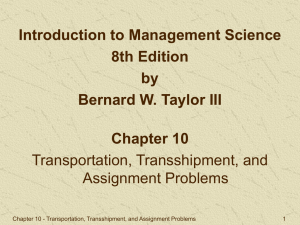Global Containerized Maritime Shipping: Emergence and
advertisement
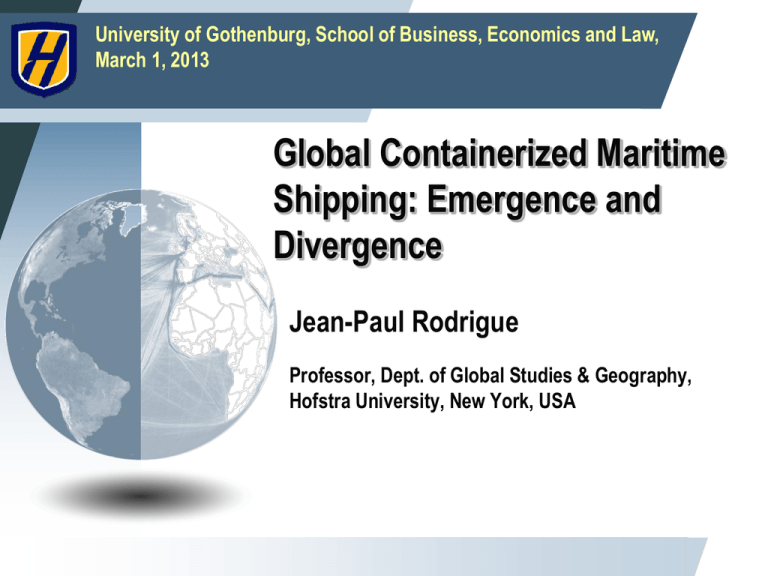
University of Gothenburg, School of Business, Economics and Law, March 1, 2013 Global Containerized Maritime Shipping: Emergence and Divergence Jean-Paul Rodrigue Professor, Dept. of Global Studies & Geography, Hofstra University, New York, USA THE EMERGENCE OF CONTAINERIZATION Density of Ship Log Entries, 1750-1810 Maritime Shipping Routes and Strategic Locations The Container as a Transport, Production and Distribution Unit Transport Modes, terminals, intermodal and transmodal operations Production Synchronization of inputs and outputs (batches) Distribution Flow management (timebased), warehousing unit Diffusion Cycle of Containerization Diffusion Level Niche markets Massive diffusion Network complexities New (niche) services Productivity gains Network development Productivity multipliers Time Containerization as a Diffusion Cycle: World Container Traffic (1980-2011) and Scenarios to 2015 1000 900 Adoption Acceleration Peak Growth 1966-1992 1992-2002 2002-2008 Maturity 2008 Reference 800 Million TEU 700 600 Divergence Depression 500 400 300 200 100 0 1980 1985 1990 1995 2000 2005 2010 2015 The K-Wave of Containerization K-Wave Traffic A Phase (Wave) B Maturity Acceleration Adoption Peak Growth Time (Decades) Transition (A) Seasonal Cycle (B) Years Source: Guerrero and Rodrigue (2013) Months Hierarchical Cluster Analysis Parameters of Global Container Ports, 1970-2010 Dissimilarity per number of classes Dissimilarity dendrogram for 7 classes 10 6.74 E 9 7.52 D.2 8 9.36 D.1 7 10.20 C 6 B.2 16.10 5 B.1 18.92 A 4 30.69 3 31.50 2 High 58.06 0 20 40 Source: Guerrero and Rodrigue (2013) 60 80 Dissimilarity Level Low Fifth Wave Fourth Wave Third Wave Second Wave First Wave The First Wave of Containerization, 1970 – The Pioneers of the Triad Pioneer ports setting containerized operations in the economic triad (North America, Western Europe, Australia and Japan). Driver: Trade substitution Source: Guerrero and Rodrigue (2013) The Second Wave of Containerization, 1980 – Adoption in the Triad and its Periphery Expansion of the triad and its trade partners (Caribbean, Mediterranean, Asian Tigers). Driver: Adoption of containerization Source: Guerrero and Rodrigue (2013) The Third Wave of Containerization, 1990 – Global Diffusion Large diffusion in new markets (Latin America, Middle East / South Asia, Southeast Asia). Driver: Setting of global supply chains. Setting of transshipment hubs. Source: Guerrero and Rodrigue (2013) The Fourth Wave of Containerization, 2000 – Global Standard The container as the standard transport support of the global economy. Driver: Expansion of global supply chains. China and transshipment hubs. Source: Guerrero and Rodrigue (2013) The Fifth Wave of Containerization, 2010 – Peak Growth Peak growth and the setting of niches. Driver: Spillover effect and new transshipment hubs. Source: Guerrero and Rodrigue (2013) Waves of Containerization, 1970-2010 Each wave lasts 8 to 10 years. Hierarchical diffusion pattern. Source: Guerrero and Rodrigue (2013) DIVERGENCE: GLOBAL TERMINAL OPERATORS AND TRANSSHIPMENT HUBS Typology of Global Port Operators Stevedores Horizontal integration (Port operations is the core business; Investment in container terminals for expansion and diversification). Expansion through direct investment. PSA (Public), HPH (Private), HHLA (Public), Eurogate (Private), ICTSI (Private), SSA (Private). Maritime Shipping Companies Vertical integration (Maritime shipping is the main business; Investment in container terminals as a support function). Expansion through direct investment or through parent companies. APM (Private), COSCO (Public), MSC (Private), APL (Private), Hanjin (Private), Evergreen (Private). Financial Holdings Portfolio diversification (Financial assets management is the main business; Investment in container terminals for valuation and revenue generation). Expansion through acquisitions, mergers and reorganization of assets. DPW (Sovereign Wealth Fund), Ports America (AIG; Fund), RREEF (Deutsche Bank; Fund), Macquarie Infrastructure (Fund), Morgan Stanley Infrastructure (Fund). Factors behind the Interest of Equity Firms in Transport Terminals Asset (Intrinsic value) Globalization made terminal assets more valuable. Terminals occupy premium locations (waterfront) that cannot be substituted. Traffic growth linked with valuation; same amount of land generates a higher income. Terminals as fairly liquid assets (perception). Source of income (Operational value) Income (rent) linked with traffic volume. Constant revenue stream with limited, or predictable, seasonality. Traffic growth expectations result in income growth expectations. Diversification (Risk mitigation value) Sectorial and geographical asset diversification. Terminals at different locations help mitigate risks linked with a specific regional or national market. Top Twelve Global Container Terminal Operators by Equity-Based Throughput, 2010 Evergreen 7.0 SSA Marine 7.5 Modern Terminals 8.0 Ports America 8.1 China Merchants 8.9 MSC 9.9 COSCO 13.6 SPIG 19.5 APM Terminals 31.6 DPW 32.6 Hutchison Port Holdings 36.0 PSA 51.3 0 10 20 30 40 Million TEUs (2010) 50 60 Container Terminal Surface of the World's Major Port Holdings, 2010 Container Terminals of the Four Major Port Holdings, 2010 The Insertion of Intermediate Hub Terminals 85% of Transshipment Traffic 15% of Transshipment Traffic Transshipment Volume and Incidence by Major Ports, 2007-09 Asia – Mediterranean Corridor Caribbean Transshipment Triangle Northern Range East Asia Cluster Gateways and Transshipment Hubs: Different Dynamics Monthly Container Traffic (Jan 2005 =100) CHALLENGES TO CONTAINERIZATION An Expected Shift in Containerization Growth Factors Derived Substitution Incidental Induced Economic and income growth Globalization (outsourcing) Fragmentation of production and consumption Functional and geographical diffusion New niches (commodities and cold chain) Capture of bulk and break-bulk markets Trade imbalances Repositioning of empty containers Transshipment (hub, relay and interlining) Evolution of Containerships Early Containerships (1956-) A 500 – 800 TEU (LOA – Beam – Draft) 137x17x9 Fully Cellular (1970-) E 8 13 B 13 6 15 5 300x43x14.5 New Panamax (2014-) 366x49x15.2 17 C 6 10 12,500 TEU 20 6 D 397x56x15.5 ; 22–10–8 (not shown) 15,000 TEU 18,000 TEU 6 5 9 Post Panamax Plus (2000-) Triple E (2013-) 4 containers high below deck 285x40x13 4,000 – 5,000 TEU Post New Panamax (2006-) A 10 9 6,000 – 8,000 TEU D 5 4 290x32x12.5 Post Panamax (1988-) C 8 6 containers across 4 containers high on deck 250x32x12.5 3,000 – 3,400 TEU 3,400 – 4,500 TEU 6 215x20x10 Panamax (1980-) Panamax Max (1985-) 4 200x20x9 1,000 – 2,500 TEU B 4 10 400x59x15.5 8 23 E The Largest Available Containership, 1970-2013 (in TEUs) “Triple E” Class (18,000 TEU) 20,000 18,000 16,000 E “Emma” Class (12,500 TEU) Ship Size in TEU 14,000 12,000 10,000 S “Sovereign” Class (8,000 TEU) 8,000 6,000 4,000 2,000 0 L “Lica” Class (3,400 TEU) R “Regina” Class (6,000 TEU) Potential Impacts of Larger Containerships on Maritime Transport Systems Shipping Network • Cascading of ship assets; Less port of call options; Changes in the frequency of services; Increase in transshipment. Port Operations • Dredging; Improved equipment; More yard storage. Hinterland • Increased congestion; Pressure to invest in infrastructures; Modal shift; Setting of inland ports. Fuel Consumption by Containership Size and Speed 400 350 Extra Slow Steaming Normal Speed Slow Steaming Fuel Consumption (Tons per day) 300 Ship Size (TEU) 250 4,000-5,000 5,000-6,000 200 7,000-8,000 8,000-9,000 150 9,000-10,000 10,000+ 100 50 0 17 18 19 20 Source: adapted from Notteboom and Carriou (2009) 21 22 Speed (Knots) 23 24 25 Containerized Cargo Flows along Major Trade Routes, 1995-2011 (in millions of TEUs) 2011 12.7 6.0 14.1 2010 12.8 6.0 13.5 2009 10.6 6.1 2008 13.4 2007 13.5 2006 13.2 2005 2004 9.0 2002 8.4 11.2 8.2 5.1 3.8 7.4 3.4 4.7 2.5 1.6 2.6 2000 7.3 3.5 4.7 2.5 1.7 2.7 6.1 1998 2.9 5.4 2.9 3.9 3.6 1996 4.0 3.6 2.6 1995 4.0 3.5 2.4 2.0 1.7 1.7 0 5 3.0 10 3.5 3.7 3.0 Asia-North America North America-Asia Asia-Europe Europe-Asia North America-Europe Europe-North America 2.3 1.7 2.1 2.2 1.6 1.7 15 2.4 3.3 3.3 2.1 1.7 2.3 4.6 3.3 3.7 2.3 1.5 2.4 1997 3.5 1.6 1.9 2.0 2.1 2.8 2.6 1.4 2.6 2001 1999 4.4 4.3 6.9 3.4 4.5 9.3 4.1 3.6 5.0 2.8 2.5 5.2 13.0 4.5 3.1 2.8 13.5 4.7 10.6 2003 5.5 5.3 3.4 5.6 11.5 6.9 11.9 6.2 20 25 30 35 40 45 50 Average Container Usage during its Life-Span 16% 16% 56% 6% 6% Ocean Transit Terminal Inland Use Repair Idle or Empty Repositioning Why Hinterland Transportation Matters? The Space / Cost Dichotomy of Forelands and Hinterlands 10% Port 80% 90% HINTERLAND FORELAND 20% Distance Costs The Inland Logistics Challenge: The “Last Mile” in Freight Distribution Capacity Funnel Frequency Funnel Inland Terminal HINTERLAND Capacity Gap Frequency Gap GATEWAY FORELAND Economies of scale Main Shipping Lane INTERMEDIATE HUB Main Routing Alternatives between the Pacific and Atlantic Main Routing Alternatives between East Asia and Northern Europe Conclusion: Potential Structure of the Global Container Transport System
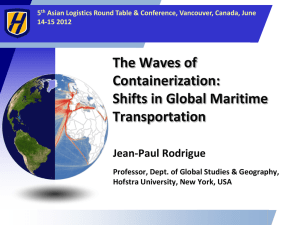

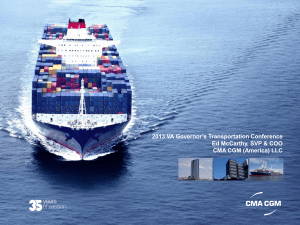
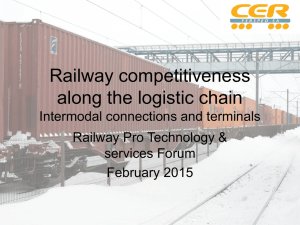

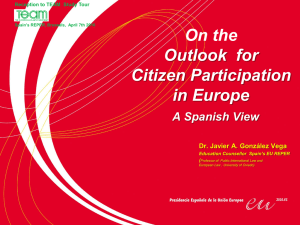

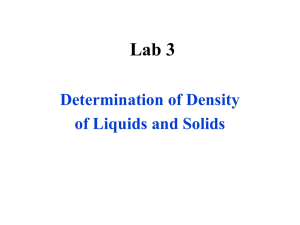
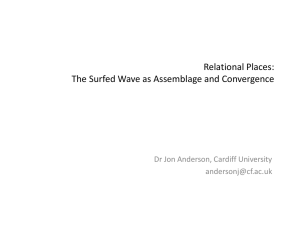
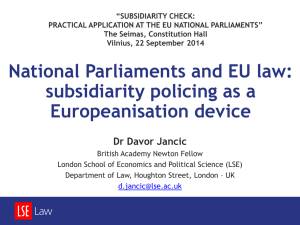
![Kaikoura Human Modification[1]](http://s2.studylib.net/store/data/005232493_1-613091dcc30a5e58ce2aac6bd3fb75dd-300x300.png)
